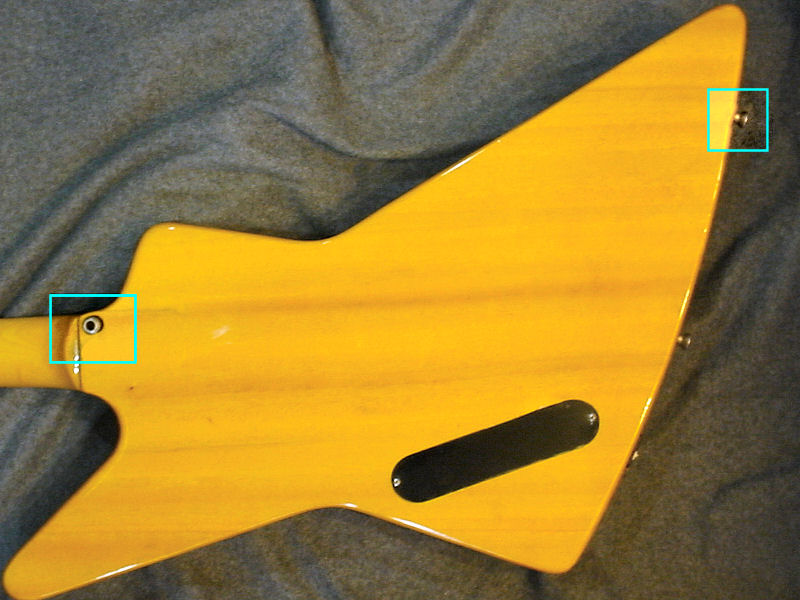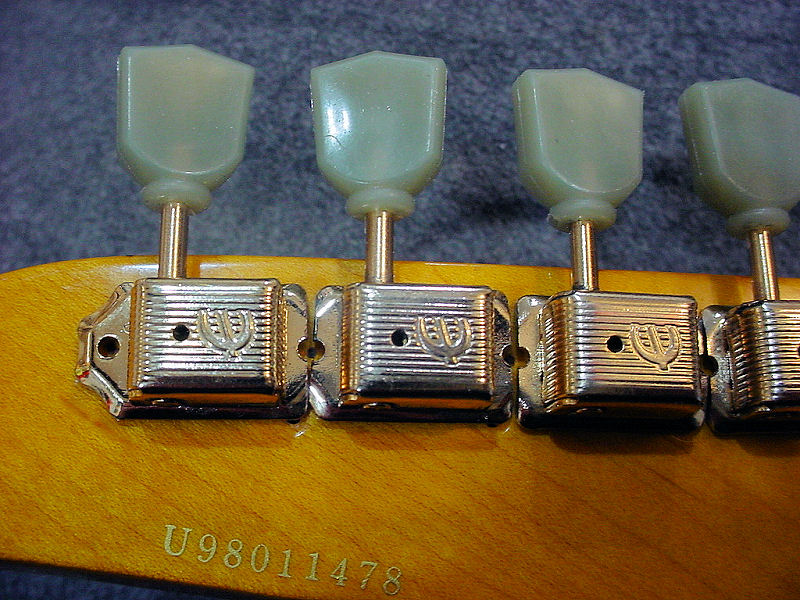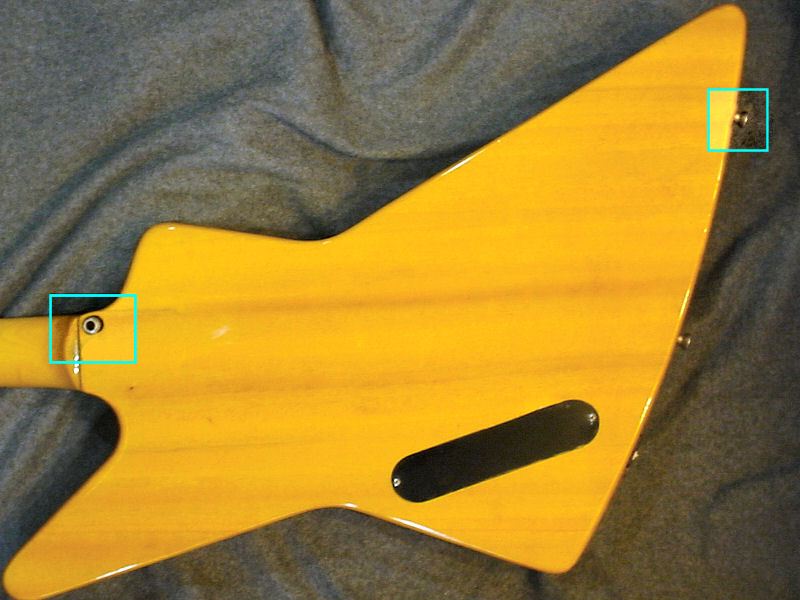Epiphone 1958 Korina Explorer Neck Heavy Fixes
Comments
I bought a used Epiphone Explorer on ebay. Ive always wanted one and this one sold cheap. A cool thing is that the serial number says that the guitar was made in January, 1998. 1998 was the first year of producton for this model.
After putting a strap on it and trying it on I was ready to send it back. It was neck heavy. When I didn't have my hands on the guitar the neck would drop toward the floor. Advice on fixing the problem is just a Google seach away. There are many webpages, blogs, and forum posts to learn from. Here are two remedies that removed the neck heavy problem for my Explorer. The guitar sits perfectly on me now.
First, I moved the forward strap button to the back of the guitar where the neck enters the guitar body. I put a small gold screw in the hole where the strap button was originally installed.
Click the image to see a larger version.

After the strap button repositioning the neck no longer dropped toward the floor. Still, the guitar's balance didn't feel quite right. It was like the body and neck weighed the same. I like guitars to have a neck that is noticeably lighter than the body.
The second remedy was to replace the tuners. I got some Kluson-style tuners (5.5 oz.) on ebay that have the Epiphone E logo on them and don't weigh as much as the stock sealed tuners (7.7 oz.). The difference is only 2.2 ounces, but this switch made a huge difference in the guitar's neck weight. I bought conversion bushings for the new tuners because the sealed tuners used a 10mm hole in the headstock and the Kluson stye tuners use a smaller hole.
Try this simple test with your Explorer. Temporarily remove the metal buttons from your stock tuners. There should be a screw on the edge of the buttons. Unscrew that and take the buttons off of all of the tuners. Take care not to lose the washers. There should be a noticeable difference in neck weight. Reproduce that difference permanently by installing new tuners like I have.
In 1958 the heavier sealed tuners didn't exist and the Explorer wasn't designed with them in mind. Nowadays, Kluson-style tuners are typically of high enough quality that they don't need to be replaced with sealed tuners. My replacement tuners work fine, look more vintage, and have a 15:1 gear ratio as well.
When I started putting the new tuners in place I realized that I'd hit a snag. The tuner holes in the Explorer headstock were too close together to let the new tuners sit properly. Instead, they overlapped each other.
Click an image to see a larger version.


I had to perform surgery on the new tuner baseplates. I measured where the new screws should go by putting a new tuner in the bottom hole and marking where the holes on the tuner baseplate would be. Then I moved that tuner up to the next hole, used the last mark I'd made for the previous hole to line up with, and made a new mark for the next screw hole. I did this on up the headstock until all tuner holes had two screw hole marks next to them.
Next I took the new tuners to my sander and sanded off the ends of the baseplates until only about 1/2 of the original screw holes remained for each tuner. I checked back and forth constantly to make sure that I wasn't sanding on an angle or sanding too much or little. Every finished tuner got put in line with the others to make sure that I wasn't drifting off of the marks I'd made earlier.
Click an image to see a larger version.


When the tuners were done I used a hand-held rotary tool to drill small holes in the headstock where I'd marked the screw hole positions earlier. Then I put the new tuners in place and screwed them down.
Click an image to see a larger version.



The front of the headstock looks better, IMO. The new tuner bushings are smaller than the stock tuner washers and everything looks nice and tidy, vintage-style.
Click an image to see a larger version.



Neck heavy? Not my Explorer.
Later...
With the current mods, I now had a problem with the the guitar slanting away from me when playing. The top of the guitar wanted to lean outward and I was straining to see the fretboard. Two strap button moves solved this beautifully. A previous owner of the guitar had moved the rear strap button from the middle of the rear edge to the top of the edge. In the picture below you can see a gold screw I used to replace this extra button.
Click an image to see a larger version.

I put that strap button back in and tried it out. Better. But the guitar still leaned outward uncomfortably. After several test moves, I put the front strap button at the top of the neck join instead of in its middle. BAM! I just nailed comfortable and easy visual access to the fretboard. Below are my final strap button placements and I'm as happy as could be. YMMV.

|











